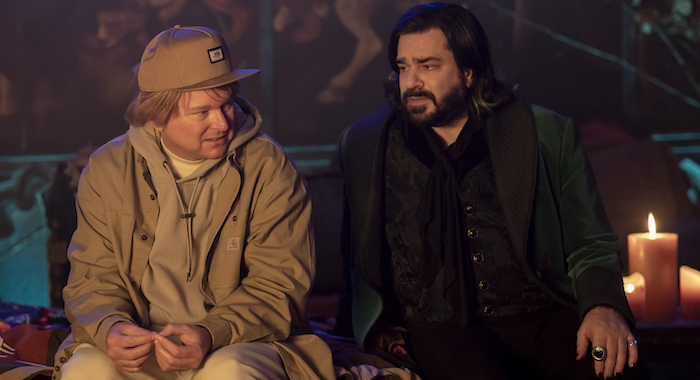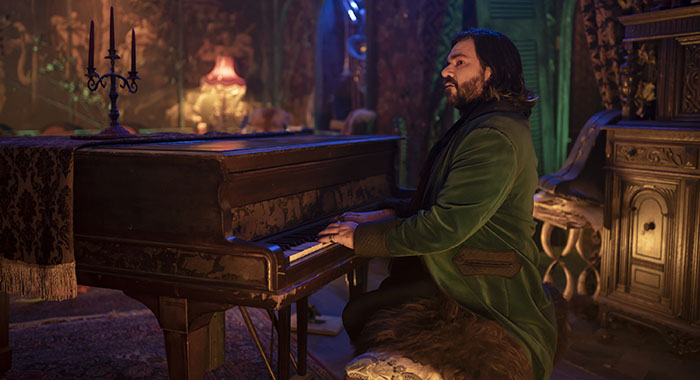TAGGED AS: Comedy, FX, television, TV, vampires

(Photo by Pari Dukovic/FX)
In the epic battle of nature versus nurture, nature has won. Or, at least it has on FX’s hit vampire series, What We Do in the Shadows.
Spoiler alert: The following reveals plot points of the season 4 finale of What We Do in the Shadows. If you haven’t watched the episode, “Sunrise, Sunset,” and wish to avoid spoilers, stop reading here.
The fourth season’s finale, which aired on September 6, saw that — despite the best efforts of one of his housemates, the dapper, blood-sucking vampire Laszlo (Matt Berry) — the regenerated and rapidly-aging energy vampire Colin Robinson (Mark Proksch) completed his metamorphosis. While he ended last season as the terrified infant who crawled from the carcass of a previous iteration of himself, this season saw him go through life phases such as a tap-dancing tween and an angsty teen until he finally emerged from his dingy basement as a replica of the dull and boring figure fans have watched feed off the energy of others for the past three seasons.
Co-showrunner Paul Simms, who wrote the season finale, and actor Proksch talked to Rotten Tomatoes about Colin Robinson’s life cycle.
Whitney Friedlander for Rotten Tomatoes: Paul, did you and the other writers plan out how and when Colin Robinson would age? Were there specific episodes over the course of the series where you knew they would have to be part of the storyline?
Paul Simms: We looked at it as we wanted, within one 10-episode season, to cover everything from baby to adulthood and hit all those milestones — at least the ones that are funny. Another show, it would have taken them 20 years what we got to do in 10 seasons. We just got to pick the best, and funniest, parts.
Mark, was there a particular phase of your life that you enjoyed revisiting?
Mark Proksch: The tween song-and-dance Colin was probably my favorite. And I was happy that I got to touch on that — also [because puberty came for Colin swiftly and suddenly] as a fully grown man in at least one scene, which was really fun to do.
Colin’s transformation from an emotional and volatile young adult to the sweater-loving bald man and glasses we already know happens after he finds detailed journal entries that were meticulously kept by at least one previous version of himself. It’s then that he fully understands what he was destined to become. Does that mean that the final phase of the evolution was him sucking the energy out of himself?
Simms: That’s interesting. Someone who doesn’t know what an energy vampire is reading hundreds of years of diaries … yeah, maybe that’s how the [transformation happens]. Science still does not have a full explanation as to how the whole process works. So that’s a very good theory.
The traditional, blood-sucking vampires on the show remember their human lives and when they were turned into vampires. It’s unclear, both to Colin and to the audience, where energy vampires originate. Paul, were you being deliberately vague? And Mark, how does this affect how you create a character?
Proksch: Well, this character is definitely three-quarters the writers and one-quarter me, as far as creating. I think a lot of the childhood stuff informs, even subconsciously, how I’ll perform Colin going forward. Maybe small touches here and there.
Simms: I think energy vampires are the most common kinds of vampires. We all know at least one or two; and if you work in an office, you probably know three or four or five. The other vampires have an extensive lore and history and books about it. But writing the energy vampire stuff is more about just observing exhausting interactions you’ve had with real people and then exaggerating them a tiny bit.
Is his name even Colin Robinson? Is there a reason why he’s referred to as both his first and last names as opposed to the others? Was this a nod to co-showrunner Stefani Robinson?
Simms: I feel like even before Stefani was on the show that he was named Colin Robinson. In the pilot, I think it was just funny that he was always referred to by both his first and last name. It’s such a bland normal name. But that is a good question about whether it’s his real name. That will be addressed in the season that we’re about to start shooting that won’t air for a year.

(Photo by Russ Martin/FX)
The show brings up the “nature vs. nature” debate and whether we are just destined to be a certain way. Why was that important?
Simms: The whole season started out as with Laszlo thinking, Can I make him into something different than he is? I have two kids of my own and we treat them basically the same way, and they’re so incredibly different. As a parent, it makes you realize that a lot of it is just baked in beforehand and there’s nothing you can do about it.
The interesting thing about Colin is he doesn’t know himself. One of my favorite scenes is when Laszlo sits him down and explains to him he’s an energy vampire and he’s frustrated and says, “It sounds like a terrible thing to be, and isn’t there any way out?” I thought that was really fun.
This also plays into the themes of renovation that happened this season. Most obviously, the series spoofs a Property Brothers–like show when “TV hosts” come to flip the vampires’ crumbling Staten Island estate.
Simms: It’s so easy in interviews to over-intellectualize it, but it started out with what was funny. And the house falling apart seemed funny; a baby Colin seemed funny … once we are done laughing about that, we try to figure out what’s the real story underneath that so it’s not just a grand bag of jokes.

(Photo by Russ Martin/FX)
The season finale episode is titled “Sunrise/Sunset.” That song, from the musical Fiddler on the Roof, is about growing older and how quickly time can pass. But it’s also a funny choice because vampires can’t see the sun. Was that intentional?
Simms: No, in fact, after we had were further into the process, I said, you know what, for vampires it would make more sense if the name of the episode was “Sunset/Sunrise.” But then they told us if we wanted to use the song [in the show], we had to stick with the original lyric.
Mark, one of the challenges of this role seems like it would be to make Colin Robinson annoying but not so annoying that the audience is turned off by him. How do you balance that?
Proksch: I think you have to play him realistically and put some realism into the character. I’m not a big fan of sketch comedy or staged improvisation shows because there’s no backstory there and usually there’s no subtlety in the performance. I think what creates endearment and a character is a little bit of reality.
Simms: I think the realer Colin is, the funnier he is. We’re so lucky to have this show where the characters are so over-the-top and just broad and insane. But Colin’s funniest moments are just the most real, mundane things.
At the end of the episode, Colin tells Laszlo that he doesn’t remember anything of the past year and, therefore, doesn’t remember how they bonded. But then he walks away and whistles a song from the past season, suggesting otherwise. So is Colin lying that he doesn’t remember the past year of his life?
Simms: I know the answer. (laughs)
Proksch: I have my theory too. But I think it’s good for debate purposes not to always lay it out in black and white. I wouldn’t want to take away any opportunity for fans to go on and on about it for the next few years.
![]() 100%
What We Do in the Shadows: Season 4
(2022)
is now streaming on Hulu in its entirety.
100%
What We Do in the Shadows: Season 4
(2022)
is now streaming on Hulu in its entirety.